
HP Designjet 111 printer series
User???s guide

HP Designjet 111 printer series
User???s guide
Trademarks
Microsoft?? and Windows?? are U.S. registered trademarks of Microsoft Corporation.

Table of contents

1 Introduction
Introduction
The front panel
The printer has a control panel at the front left, known as the front panel.
The front panel has two lights (LEDs), three keys to control printing operations, and a display screen to provide information.
There are two
???The Power light is green. It is off when the printer is off. It flashes while the printer is printing or is in the process of turning off. Otherwise it is on to indicate that the printer is on.
???The Attention light is yellow. It flashes to indicate an error or problem; icons in the

Introduction
There are three
???The Power key is the bottom key on the front panel. It turns the mains power on and off.
 NOTE: The Power key is a 'soft' switch, and the printer still has electrical power available to it, even when switched off. To isolate the printer from the mains supply, you must unplug it.
NOTE: The Power key is a 'soft' switch, and the printer still has electrical power available to it, even when switched off. To isolate the printer from the mains supply, you must unplug it.
???The Cancel key is the upper left key on the front panel. It cancels the current operation.
???The OK key is the upper right key on the front panel. It indicates to the printer that you have now loaded paper in the appropriate tray or feed, so that the printer can start printing. It can also indicate to the printer that you have corrected a
The above diagram shows all the features and icons that may appear on the display screen. The notification icons appear above and the ink system status information below.
From left to right, the icons are Busy, Paper misaligned, Roll loaded (on) or Roll empty/stuck (flashing), No paper, Waiting for OK, Paper jam, Run System Maintenance.
From left to right, the inks are black, cyan, magenta, yellow. The ink levels in each cartridge are indicated approximately by the black squares.
 NOTE: No cartridges or printheads are shown if any cover is open or the rear path is removed.
NOTE: No cartridges or printheads are shown if any cover is open or the rear path is removed.
For details of how to react when a problem occurs, see The printer's yellow light is flashing on page 41.
Windows printer software
The Windows driver for use with your printer is available on the HP Designjet 111 Software and Documentation CD. Use this driver for printing drawings and office documents from applications such as AutoCAD, Word, Excel, PowerPoint, Acrobat Reader and Web browsers.
The driver is compatible with Windows XP, 2003 Server, Vista, 2008 Server and Windows 7.
Driver features include:
???Print quality (Fast/Normal/Best)
???Orientation (Portrait/Landscape/Rotate by 90 degrees/Mirror Print)
???Paper type
???Paper size (standard and customized)
??? HP Designjet 111 Roll: Disable automatic cutter, Remove top/bottom blank areas, Autorotate
??? HP Designjet 111 Tray: Print on both sides, Multiple pages per sheet, Start printing from the last page
The driver provides the following print resolutions.
???Fast: 300 dots per inch
???Normal: 300 dots per inch (default)
???Normal: 600 dots per inch (optimized for drawings/text)
???Best: 600 dots per inch
In addition to the printer driver, a
Mac OS printer software
The Mac OS driver for use with your printer is available on the HP Designjet 111 Software and Documentation CD. Use this driver for printing drawings and documents from applications such as Photoshop, Illustrator, Freehand, QuarkXpress, CorelDRAW, InDesign, PageMaker, Painter, Archicad and VectorWorks.
The driver is compatible with Mac OS X 10.4, 10.5 and 10.6.
Driver features include:
???Custom page size
???Orientation (Portrait/Landscape/Mirror)
???Scale (percentage)
???Paper type
???Quality (Draft/Normal/Best)
???Color options
The driver is configured using the Page Setup and Print dialogs.
In addition to the printer driver, a

Introduction
The roll feed
The roll feed is supplied with the HP Designjet 111 Roll printer. It allows the printer to print on a roll of paper up to 610 mm (24 in) wide. It includes an automatic cutter.
The roll is loaded from the rear of the printer and must be fed into the rear feed slot.
Once a print job to a roll has finished, the printer will automatically cut the roll. However, the cutter can be disabled from the printer driver. The printer also cuts the roll if you press the OK key.
 NOTE: If a roll of paper is loaded and you want to print to a cut sheet, you must first unload the roll.
NOTE: If a roll of paper is loaded and you want to print to a cut sheet, you must first unload the roll.
The HP Jetdirect print server
The HP Jetdirect print server is a network card that can be installed in the printer. It allows the printer to be connected to a network, allowing the printer to be accessed from different computers on the network.
To install the card, first turn off and unplug the printer. Then remove the blank plate from the rear left of the printer, and insert the card in its place.
The card connects to the network via the socket on its

Introduction

2 Connection and software installation
install & Connect
Install the Windows printer driver
1.Insert the HP Designjet 111 Software and Documentation CD into your CD drive.
2.If the CD does not autorun, run the setup.exe program in the root directory of the CD.
3.Follow the instructions on the screen.
Connect using a USB cable (Windows)
USB is the preferred solution for a direct
1.Do not connect the computer to the printer yet. First, install the Windows printer driver: see Install the Windows printer driver on page 6.
2.When asked how the printer is connected, choose Connected directly to this computer.
3.Choose USB and click Next.
4.Choose your printer model and click Next.
5.When prompted to do so, connect your computer to the printer, using a USB cable. Ensure that the printer is switched on. When the printer software has detected the printer, the installation process will be completed automatically.
Connect using a parallel cable (Windows)
Use the parallel port only if your system does not support USB. A parallel connection is slower than USB and restricts the functionality available: in particular, not all functions of HP Designjet System Maintenance will be available.
1.Turn off both printer and computer before connecting them via the parallel port, to avoid damaging your equipment.
2.Connect the parallel cable from your computer to the printer.
 NOTE: The cable must be IEEE 1284 compliant.
NOTE: The cable must be IEEE 1284 compliant.
3.Turn on the computer and the printer.
4.Install the Windows printer driver: see Install the Windows printer driver on page 6. If the Add New Hardware Wizard appears on your screen, click Cancel.
5.When asked how the printer is connected, choose Connected directly to this computer.
6.Choose Parallel cable and your parallel port number, and click Next.
7.Choose your printer model and click Next.
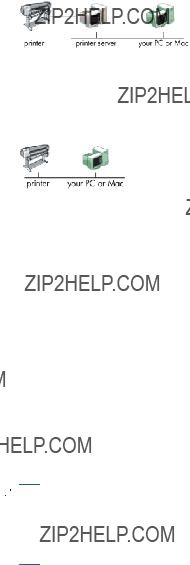
Network connection methods
The HP Jetdirect print server allows you to connect the printer to a network. See The HP Jetdirect print server on page 4 and your HP Jetdirect documentation.
There are two ways of using it to connect the printer to a network.
???
Configure a direct network connection (Windows)
In order to set up a direct network connection, you must configure the IP address of the HP Jetdirect print server. There are two cases, depending on the kind of IP address configuration on your network. Follow only the steps that apply to your network architecture.
Automatic IP address configuration
In this case, once the network cable is connected and the printer is powered up, the Jetdirect card automatically takes an IP address. You need to get this value and perform the following steps to configure the printer in the network.
1. Print the printer's information pages, by pressing the OK key four times while holding the Power key, then releasing the Power key.
2. Identify the value of the IP address in the TCP/IP section of the first page (I/O page).
 NOTE: If the printer's IP address is shown as 0.0.0.0, this is an error. Wait five minutes, then print the information pages again. If the IP address remains 0.0.0.0, reset the Jetdirect card, as follows: on the printer's front panel, hold down the Power key while pressing the Cancel key three times and then the OK key once. Then interrupt the power supply to the printer, by pulling out the power plug and then plugging it back in again.
NOTE: If the printer's IP address is shown as 0.0.0.0, this is an error. Wait five minutes, then print the information pages again. If the IP address remains 0.0.0.0, reset the Jetdirect card, as follows: on the printer's front panel, hold down the Power key while pressing the Cancel key three times and then the OK key once. Then interrupt the power supply to the printer, by pulling out the power plug and then plugging it back in again.
3. Insert the HP Designjet 111 Software and Documentation CD into your computer.
4. Select your printer series (HP Designjet 111).
5. Choose Install.
6. Read the information in the Welcome dialog, and read and accept the licence agreement.
7. Read the firewall notice and mark the check box to continue installation without network connection, or simply click Next to continue with printer discovery.
8. The installer tries to find the printer automatically. If it is successful, select your printer and click Next to complete the installation. Otherwise, continue with the following steps.
9. Choose Connected to the network.

install & Connect
10.Choose Specify printer by address.
11.Enter the printer's IP address in the applicable text box and click Next.
12.Wait until the configuration program analyzes the printer and the network. The program detects the network settings and suggests the settings to be applied for the printer's configuration. Normally, it is not necessary to change any of these settings, so click Next.
13.Follow the process in the HP Designjet 111 Software and Documentation CD until the installation is finished.
Manual IP address configuration
In this case, there is no IP address at the moment of starting the installation. The installation process will consist of detecting the printer, configuring its IP address and installing the driver with these settings. Perform the following steps.
1.Print the printer's information pages, by pressing the OK key four times while holding the Power key, then releasing the Power key.
2.Identify the value of the hardware (HW) address in the first page (I/O page).
3.Insert the HP Designjet 111 Software and Documentation CD into your computer.
4.Select your printer series (HP Designjet 111).
5.Choose Install.
6.Read the information in the Welcome dialog, and read and accept the license agreement.
7.Read the firewall notice and mark the check box to continue installation without network connection, or simply click Next to continue with printer discovery.
8.The installer tries to find the printer automatically. If it is successful, select your printer and click Next to complete the installation. Otherwise, continue with the following steps.
9.Choose Connected to the network.
10.Choose Specify printer by address.
11.Enter the printer's hardware address in the applicable text box and click Next.
 NOTE: Hardware addresses are seen only at one side of a gateway, so make sure there is no gateway between your computer and the printer. In practice, this means the computer and the printer should be on the same subnet.
NOTE: Hardware addresses are seen only at one side of a gateway, so make sure there is no gateway between your computer and the printer. In practice, this means the computer and the printer should be on the same subnet.
12.The program analyzes the network and the printer. As there are no TCP/IP parameters configured, the program asks you to enter the IP address, the subnet mask and the gateway. Enter these values according to your network configuration. Take care, when choosing the IP address and the subnet mask, that you select values that will not create conflicts with the current network devices. It is recommended that you get these values from your network administrator.
13.At the end of the installation, your driver is configured to work with your printer and your printer has a valid IP address. In order to see this IP address, you can print the information pages again and check the I/O page.
Configure a
If you have the printer directly connected to a computer (using USB, parallel or direct network setup) and shared, you can use the computer to which the printer is attached as a print server.

Share the printer
In order to be able to perform a client installation, the printer must be shared in the computer that will act as a print server.
1.Select Start > Settings > Printers.
2.
3.Go to the Sharing tab.
4.Select Shared as and select the sharing name of the device.
5.If the computers you are going to connect as clients have different Windows versions, you may need to install additional drivers for these other operating systems. In order to do so, click Additional drivers and follow the screen instructions.
Install the Mac OS printer driver
1.Insert the HP Designjet 111 Software and Documentation CD into your CD drive.
2.In Finder, navigate to the CD. You will see the Mac OS X HP Designjet Installer icon.
3.
4.The installer takes you through various steps until you reach the main install dialog box. You have the following three options.
???Easy Install: we recommend that you choose this option, which will install all components.
???Custom Install: you can choose the component you want to install (the driver, the System Maintenance utility, or both) using the check boxes.
5.Click Install.
6.The HP Printer Setup Assistant is displayed. Follow the instructions on the screen until the installation is complete.
If you want to delete the print queue at some later time, follow these instructions.
???Under Mac OS X 10.4, 10.5 or 10.6: from the system preferences, select the Printing pane of the Print & Fax dialog. Select the name of the printer and click the ??? button.
???Under Mac OS X 10.4: from the Print Setup utility, select the name of the printer and click the
Delete icon.
 NOTE: Under Mac OS X 10.4, both methods are available.
NOTE: Under Mac OS X 10.4, both methods are available.
Connect using a USB cable (Mac OS)
1.Install the Mac OS printer driver: see Install the Mac OS printer driver on page 9.
2.When the driver has been installed, the HP Printer Setup Assistant starts automatically, to set up a connection to your printer.
3.Make sure that the printer is turned on and connected to the computer with a certified USB cable.
 NOTE: The use of
NOTE: The use of
4.In the HP Printer Setup Assistant, click Continue.
Connect & install

install & Connect
5.In the list of printers that appears, select the entry that uses the connection type USB, and click
Continue.
6.The following screen displays information about your printer's installation, where the name of the printer can be modified. Make any changes you wish to make, and click Continue.
7.Your printer is now connected. In the Printer Queue Created screen, click Quit to exit, or Create New Queue if you want to connect another printer.
8.When the HP Printer Setup Assistant has finished, you can remove the CD from the CD drive.
If the printer driver is already installed, the HP Printer Setup Assistant can be run at any time from the CD.
Connect to a network using Bonjour (Mac OS)
Before you begin, check that the following statements are true.
???The printer is set up and turned on.
???The Ethernet hub or router is on and functioning properly.
???All computers on the network are on and connected to the network.
???The printer is connected to the Ethernet network.
To connect your printer, follow these steps.
1.Print your HP Designjet printer information pages by pressing the OK key (upper right key on the front panel) four times while holding down the Power key, then releasing the Power key. Note the hardware address on the first page.
2.Install the Mac OS printer driver: see Install the Mac OS printer driver on page 9.
3.When the driver has been installed, the HP Printer Setup Assistant starts automatically, to set up a connection to your printer. Follow the instructions on your screen.
4.When you reach the Select Printer screen, look for your printer's hardware address (which you noted in step 1) in the Printer Name column.
???If you find the right printer name, scroll sideways to see the Connection Type column, and check that it shows Bonjour/Rendezvous. Then highlight that line. Otherwise, continue searching further down the list.
???If you cannot find your printer name with a Bonjour/Rendezvous connection type, check the box My printer is not in the list.
Click Continue.
5.Continue following the instructions on the screen. When you reach the Printer Queue Created screen, click Quit to exit, or Create New Queue if you want to connect another printer to the network.
6.When the HP Printer Setup Assistant has finished, you can remove the CD from the CD drive.
If the printer driver is already installed, the HP Printer Setup Assistant can be run at any time from the CD.

Connect to a network using TCP/IP (Mac OS)
Before you begin, check that the following statements are true.
???The printer is set up and turned on.
???The Ethernet hub or router is on and functioning properly.
???All computers on the network are on and connected to the network.
???The printer is connected to the Ethernet network.
To connect your printer, follow these steps.
??? If you find the right printer name, scroll sideways to see the Connection Type column, and check that it shows IP Printing. Then highlight that line. Otherwise, continue searching further down the list.
??? If you cannot find your printer name with an IP Printing connection type, check the box My printer is not in the list.
Click Continue.
5.Continue following the instructions on the screen. When you reach the Printer Queue Created screen, click Quit to exit, or Create New Queue if you want to connect another printer to the network.
6.When the HP Printer Setup Assistant has finished, you can remove the CD from the CD drive.
If the printer driver is already installed, the HP Printer Setup Assistant can be run at any time from the CD.
Share a printer (Mac OS)
If your computer is connected to a network, you can make your directly connected printer available to other computers on the same network.
1.
2.Under Mac OS X 10.4, enable printer sharing by going to Sharing > Services > Printer Sharing.
Under later versions of Mac OS X, go to Sharing, select Printer Sharing, and then check the printer(s) that you want to share.
3.Your printer now automatically appears in the list of shared printers displayed by any other computer running Mac OS and connected to your local network.
Any other people wishing to share your printer must install the printer software on their own computers. They will be able to send print jobs, but will not be able to receive information from the printer.
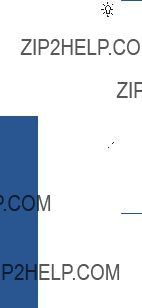
install & Connect
You may find that sharing your directly connected printer with other users will slow down your computer unacceptably.
TIP: The best way to share the printer over a network is to connect the printer not to any computer, but to the network.
Change the IP address of the HP Jetdirect print server
You may need to do this if you are moving the printer from one LAN subnet to another, and need to change the IP address because of a conflict.
 NOTE: If you are using the DHCP protocol, you do not need this procedure, because the addresses are assigned automatically.
NOTE: If you are using the DHCP protocol, you do not need this procedure, because the addresses are assigned automatically.
NOTE: This procedure will not work if the print server is not correctly configured, either because of an error or because it is a brand new card.
The correct procedure depends on your operating system.
First, print the configuration pages of the HP Jetdirect print server, in the following way.
1.Press and hold down the Power key (the bottom key on the front panel).
2.Press the OK key (the upper right key on the front panel) four times while the Power key is pressed.
3.Release the Power key. The printer prints the configuration pages.
Look for the TCP/IP area in the printed configuration pages, which contains the current IP address of the HP Jetdirect print server, in the format 'nnn.nnn.nnn.nnn' (where each nnn is a number between 0 and 255).
Windows
If you are using a Jetdirect card that already has an IP address, skip to step 7.
If you are using a Jetdirect card that has an IP address of 192.0.0.192, begin at step 1.
1.At your computer, click Start > Control Panel > Network Connections.
2.
3.Select Internet Protocol (TCP/IP) and click Properties.
4.Select Use the following IP address.
5.Change the IP address to 192.0.0.193.
6.Change the subnet mask to 255.255.255.0. Leave the other fields empty. Click OK to close the menus.
7.Open a Web browser and type the IP address of your printer.
8.Click the Networking button.
9.Select TCP/IP from the menu at the top of the page and then select Manual from the IP Configuration Method
10.Enter the IP address and subnet mask in the appropriate fields. Click the Apply button.
11.If your Jetdirect card previously had an IP address of 192.0.0.192, open the Control Panel's Network Connections and change the TCP/IP configuration back to its original configuration.
Mac OS
If you are using a Jetdirect card that already has an IP address, skip to step 13.
If you are using a Jetdirect card that has an IP address of 192.0.0.192, begin at step 1.
Get the current network configuration information
While holding the printer's Power key down, press the OK key (upper right key) four times. Three pages with information about the printer and its peripherals will be printed. If an HP Jetdirect print server is connected to the printer, the first page will contain information about the print server settings.
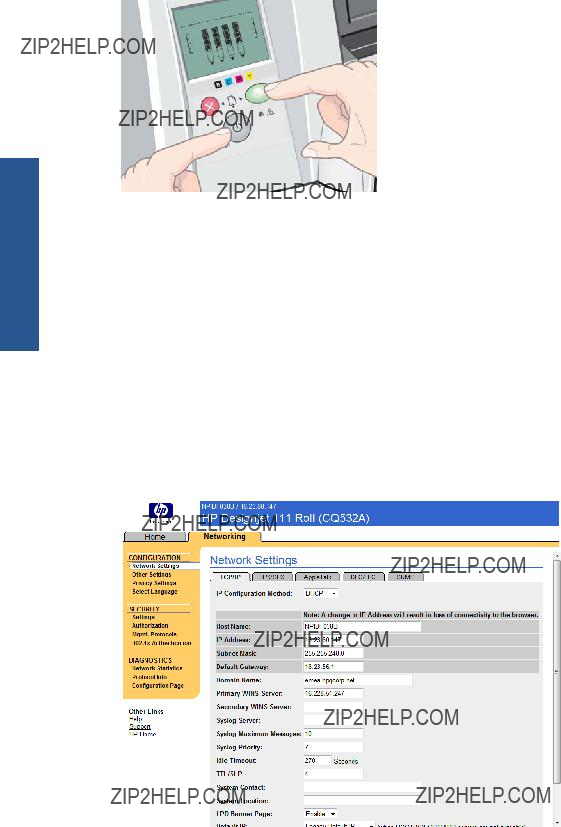
install & Connect
Change the network parameters
Once the Jetdirect card has a valid IP address, changing the rest of the network parameters (or the IP address itself, if necessary) is very easy. You need only connect to the HP Jetdirect card's embedded Web server and configure the information in the Networking tab of the Web page. To connect to the card's embedded Web server, start your Web browser and, in the browser's address field, enter the IP address of the printer.
Here you can change the parameters of each of the supported network protocols or, for example, view network statistics or set an administrator password. In the Home tab, among other information, you can see the device to which the Jetdirect card is connected and the hardware address.
If you need to change the IP parameters, the first step must always be to change the IP configuration method from BOOTP or DHCP to Manual.
If the screen you see is not in your preferred language, click Select Language on the
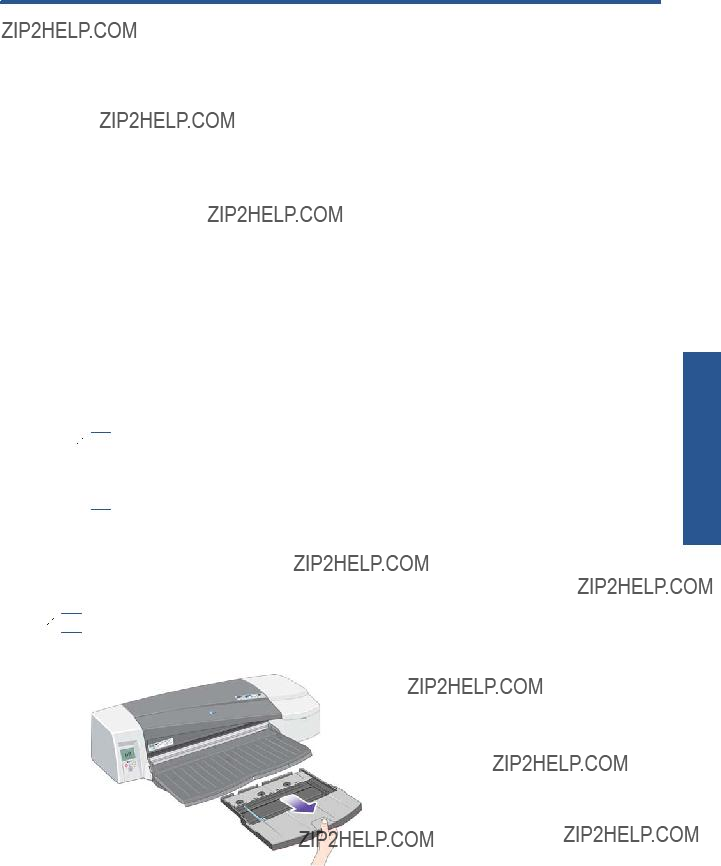
3 Paper handling
Cut sheets of paper can be loaded into the printer in the following ways.
???The front path takes single sheets of paper up to D+ size (610 ?? 914 mm); use this slot for paper that needs special care in handling. You can also use this slot to print on the back of an already printed sheet. To use this slot, select Front manual feed in your software.
???The rear path takes single sheets of paper; it is designed to provide a straight paper path for printing on thicker paper (up to 0.3 mm), such as card stock or labels, without bending. To use this path, select Rear manual feed in your software.
???The input tray provided with the HP Designjet 111 Tray printer holds up to 100 sheets of paper, depending on the paper thickness. You should use this tray to hold paper that you use often. To use this tray, select Tray 1 in your software.
 NOTE: The tray must be extended for paper that is larger than Legal- or
NOTE: The tray must be extended for paper that is larger than Legal- or
NOTE: The output tray holds up to 50 sheets.
Load paper from the input tray
If you have the HP Designjet 111 Tray printer, you can load cut sheets and envelopes from the input tray.
 NOTE: The input tray has two feet that must rest on the table.
NOTE: The input tray has two feet that must rest on the table.
1.Remove the input tray.
Paper handling

2.Lift up the tray cover.
3.If the paper you are using is larger than Legal- or
Paperhandling  4. Riffle the paper. This helps to prevent adjacent sheets of paper from sticking to each other.
4. Riffle the paper. This helps to prevent adjacent sheets of paper from sticking to each other.

5.Slide the paper into the tray under the tray cover, ensuring that it touches the sides of the tray on the right and on the printer side.
6.Push in the small tab on the right of the tray so that it fits snugly against the paper. Move the larger tab on the left of the tray so that it too fits snugly against the paper.
Load paper into the front path
 NOTE: The front
NOTE: The front
1.Place the paper in the output tray, aligning it on the right of the output tray, with the side that is to be printed on down.

handling Paper
2.If the paper is large enough to hang over the edge of the tray, pull out one or both of the tray extensions to support it.
3.Push the paper into the printer, pushing it in as far as it will go, while maintaining its alignment to the right.
4.Press the OK key (the upper right key) on the front panel.
 NOTE: You can press the OK key to load paper before sending a job to the printer; you should also press this button if the paper fails to load, to tell the printer to try to load it again.
NOTE: You can press the OK key to load paper before sending a job to the printer; you should also press this button if the paper fails to load, to tell the printer to try to load it again.
5.The printer checks the alignment of the paper, and ejects it if it is misaligned; in that case, you must reload the paper.
6.Select Front manual feed as the paper source in the printer driver.

Load paper into the rear path
1.Place the paper in the rear feed, to the left as seen from the rear, with the side upwards that is to be printed on. Align the paper with the left mark on the rear feed. Make sure that the sheet is
2.Push the paper as far as it will go into the printer.
3.Select Rear manual feed as the paper source in the printer driver.
Unload a sheet of paper
If you have the HP Designjet 111 Tray printer, remove the sheet from the output tray, where the printer leaves it after printing.
If you have the HP Designjet 111 Roll printer:
???The sheet is moved to a position where you can easily remove it, but it is not completely ejected from the printer.
???When the printer needs another sheet (or a roll) to continue printing, it attracts your attention by activating the Paper Status and Waiting for OK icons on the front panel. It also beeps and flashes a yellow light. You should remove the printed sheet, insert the next sheet into the printer and press the OK key. If you are using the rear path, you do not need to press the OK key: the paper sensor detects that a sheet is being loaded.
Paper handling

Load a roll of paper
If you have the HP Designjet 111 Roll printer, you can load rolls of paper. See The roll feed on page 4.
1.Load a roll of the required paper onto the spindle. Ensure that the roll is the right way round and that the blue stop on the spindle is pushed in against the paper.
7.The printer checks the alignment of the paper. If the paper is properly aligned, the roll icon appears on the display, indicating that the printer is ready to print.
If the paper is misaligned, the printer ejects the paper and the display shows the misaligned and roll icons; in that case, you must reload the paper.
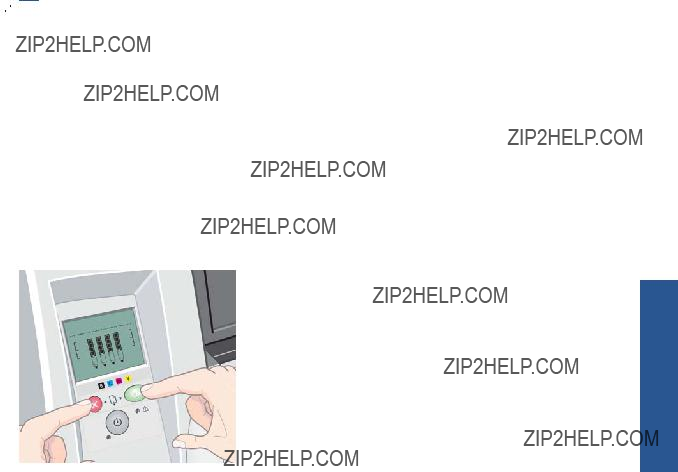
8.When printing on roll paper, ensure that the paper source in the printer driver is set to Roll (also see the note about Auto Select/Automatic below). You must also select the page size.
9.Rewind any excess paper so that the paper is rolled tightly onto the spindle.
 NOTE: Only one source of paper can be used by the printer at any one time. If a roll is loaded, it must be unloaded before printing to a cut sheet.
NOTE: Only one source of paper can be used by the printer at any one time. If a roll is loaded, it must be unloaded before printing to a cut sheet.
NOTE: If a roll of paper is loaded and you have the paper source in the printer driver set to Auto Select (Windows) or Automatic (Mac OS), print jobs will be automatically printed to the roll.
NOTE: You can cut a roll without unloading it by pressing the OK key (upper right key on the front panel); the paper first advances about 1 cm (0.4 in).
NOTE: Normally the paper is cut automatically after printing is completed; however, a driver option allows the cutter to be disabled.
Unload a roll of paper
To unload a roll from the HP Designjet 111 Roll printer, press the Cancel and OK keys on the front panel at the same time.
Paper handling

4 Printing
Printing
Select print quality
The printer has various
Therefore, you can select from the
You can select
???In the Windows driver dialog: go to the Paper/Quality tab and look at the Print Quality section.
???In the Mac OS Print dialog: go to the Paper Type/Quality panel and select Paper.
Select paper size
The paper size can be specified in the following ways.
 NOTE: The paper size specified here should be the paper size in which the document was created. It is possible to rescale the document to a different size for printing. See Rescale a print
NOTE: The paper size specified here should be the paper size in which the document was created. It is possible to rescale the document to a different size for printing. See Rescale a print
???In the Windows driver dialog: select the Paper/Quality tab, then select your paper size from the Size is
???In the Mac OS Page Setup dialog: select your printer from the Format for list, then select your paper size from the Paper Size list.
 NOTE: If your application offers no Page Setup dialog, please use the Print dialog.
NOTE: If your application offers no Page Setup dialog, please use the Print dialog.
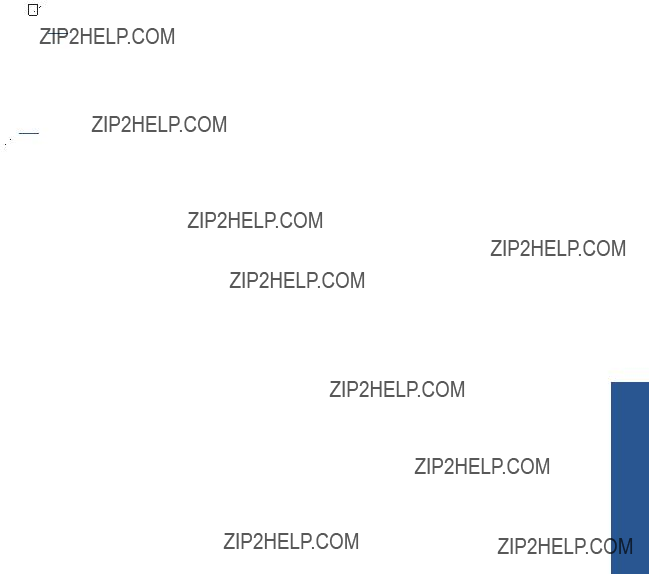
Custom paper sizes
To choose a
???Under Windows, there are two different ways:
???In the driver dialog, click the Custom button in the Paper/Quality tab. In the Custom Paper Sizes dialog box, select a name for your custom paper size: you can select Custom 1 to Custom 5. Then specify the paper dimensions, and click Save to save your new paper size.


 NOTE: The driver will not allow you to create a paper size whose width exceeds its length.
NOTE: The driver will not allow you to create a paper size whose width exceeds its length.
???From the Start menu, select Control Panel > Printers, then
???Under Mac OS: select Paper Size > Manage Custom Sizes in the Page Setup dialog.
 NOTE: If your application offers no Page Setup dialog, please use the Print dialog.
NOTE: If your application offers no Page Setup dialog, please use the Print dialog.
Printer minimum margins
The printer leaves a minimum 5 mm (0.2 in) margin between the edges of your image and the edges of the paper, increased to 12 mm (0.5 in) at the foot of
Rescale a print
You can send an image to the printer at a certain size but tell the printer to rescale it to a different size (normally larger). This may be useful if your software or your computer cannot cope with a large image.
You can rescale an image in the following ways:
??? In the Windows driver dialog: select the Effects tab, then select an option from the Resizing
??? In the Mac OS Print dialog: select the Paper Handling panel, then Scale to fit paper size, and select the paper size to which you want to scale the image. If you want to increase the size of the image, make sure that the Scale down only box is unchecked.
If you are printing to a single sheet, you must ensure that the image can actually fit onto the sheet, otherwise the image will be clipped.

Printing
Preview a print
Previewing a print on the screen allows you to check the layout of the print before printing, which may help you to avoid wasting paper and ink on a bad print.
???To preview a print under Windows, you have the following options:
???Use your application's print preview option.
???Check the Show Print Preview box, which you can find in the driver's Paper/Quality tab and Finishing tab.
???To preview a print under Mac OS, you have the following options:
???Use your application's print preview option.
???Click the Preview button at the bottom of the Print dialog box. This is the basic print preview provided by Mac OS.
???Click the PDF button at the bottom of the Print dialog box, then click HP Print Preview. This provides a preview with more features, such as the ability to change paper size, paper type and print quality, and to rotate the image.
 NOTE: HP Print Preview is not available if you are using Adobe InDesign, Adobe Illustrator, Adobe Reader or Apple Aperture.
NOTE: HP Print Preview is not available if you are using Adobe InDesign, Adobe Illustrator, Adobe Reader or Apple Aperture.
Print in gray shades
You can convert all colors in your image to shades of gray in the following ways:
???In your application program: many programs provide this option.
???In the Windows driver dialog: go to the Color tab and look at the Color Options section. Select
Print in Grayscale.
???In the Mac OS Print dialog: go to the Paper Type/Quality panel and select Color, then select Print In Grayscale.
Use paper economically
Here are some recommendations for making economical use of paper:
???You may be able to save some roll paper by using the following options:
???In the Windows driver dialog: select the Paper/Quality tab, press the Advanced Paper Settings button, and check the boxes for Remove Top/Bottom Blank Areas and/or Autorotate.
???In the Mac OS Print dialog: select the Paper Type/Quality panel, then Paper, then Remove Top/Bottom Blank Areas.
???If you check the print preview on your computer before printing, you can sometimes avoid wasting paper on prints containing obvious mistakes. See Preview a print on page 24.

Use ink economically
Here are some recommendations for making economical use of ink.
???For draft prints, use plain paper and select Fast print quality.
???Clean the printheads only when needed, and clean only those printheads that need cleaning. Cleaning the printheads can be useful, but it uses a small amount of ink.
???Leave the printer permanently turned on so that it can maintain the printheads in good condition automatically. This regular printhead maintenance uses a small amount of ink. However, if it is not done, the printer may need to use much more ink later to restore the health of the printheads.
Printing

5
Replace ink cartridges
1.Open the front hinged flap at the right of the printer.
2.Gripping it by its shorter top edges, lift the ink cartridge vertically up and out of the printer.
3.Lower the new ink cartridge into its slot until it clicks into place and is quite secure.
maintenance Ink
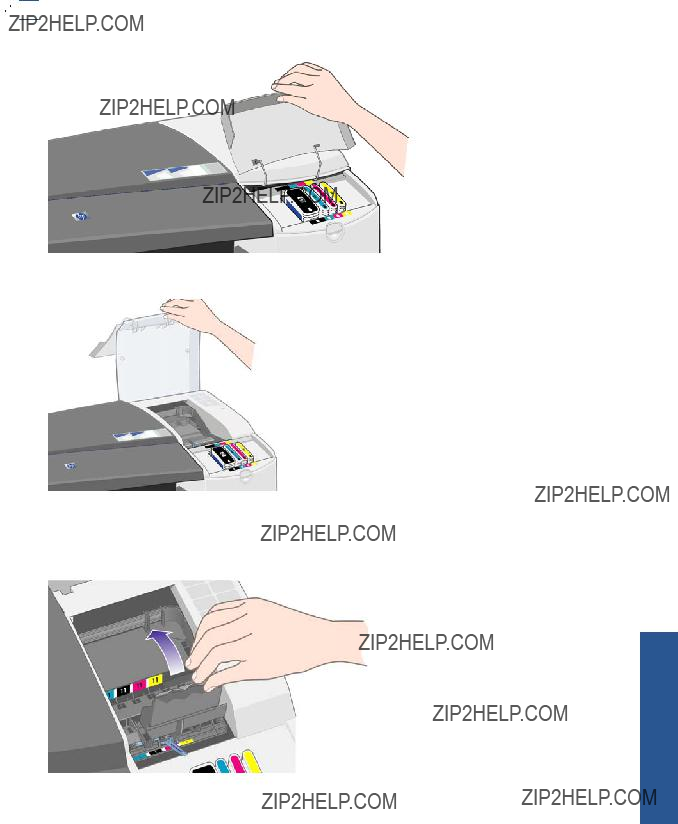
4.Repeat the preceding two steps for each ink cartridge that you wish to replace.
5.Close the outer flap.
Replace printheads
 NOTE: After a printhead is replaced, the printer will automatically realign the printheads.
NOTE: After a printhead is replaced, the printer will automatically realign the printheads.
1.Open the front hinged flap at the right of the printer.
2. Open the second (back) part of the flap and lift it right back.
3.The print carriage will move to the left and then back to the right. Wait for it to stop.
4.Pull the printhead cover up and towards you, so that the hook at the front unlatches itself, and then push the whole cover back so that the printheads are exposed.
Ink maintenance
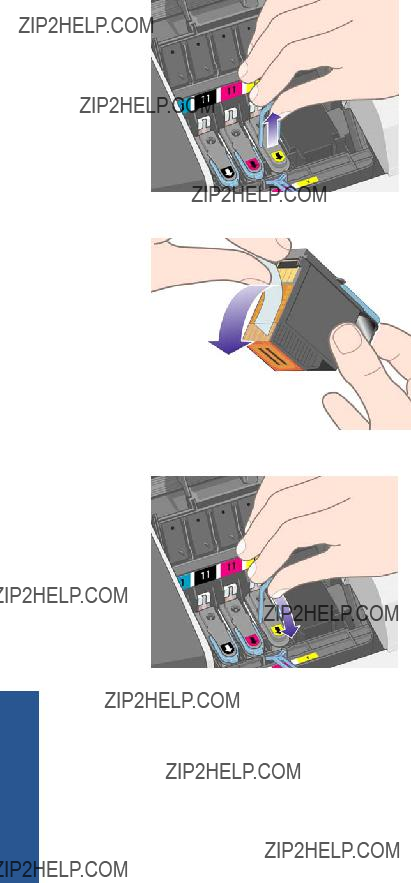
5.Lift the small handle at the top front and use it to pull the printhead vertically up and out of the printer.
6.Take the new printhead and remove the tape that protects its electrical contacts and ink nozzles.
7.Lower the new printhead into place and close its small handle.
maintenance Ink

8.Push the printhead gently into place, so that it is quite secure.
9.Repeat the preceding four steps for each printhead that you wish to replace.
10.Pull the printhead cover towards you, ensuring that the hook at its front edge latches onto the tab, and then push it away from you to close the cover.
11. Close the rear part and then the front part of the outer flap.
Ink maintenance

Supplies
6 Supplies and accessories
Supported paper types
The following paper types are currently provided for use with your printer.
 NOTE: This list is likely to change over the course of time. For the latest information, see http://www.hp.com/go/111/accessories/.
NOTE: This list is likely to change over the course of time. For the latest information, see http://www.hp.com/go/111/accessories/.
NOTE: Paper types that HP does not support may nevertheless be compatible with your printer.
Key to availability:
???(A) indicates papers available in Asia (excluding Japan)
???(E) indicates papers available in Europe, the Middle East and Africa
???(J) indicates papers available in Japan
???(L) indicates papers available in Latin America
???(N) indicates papers available in North America
If the part number is not followed by parentheses, the paper is available in all regions.
Table

Table
TIP: The dye inks used by your printer will fade very quickly on
Table
Supplies

Supplies
Table
Supported paper sizes
Roll paper
The minimum width of roll paper is 4.3 in (110 mm) and the maximum width is 24 in (610 mm).
Order ink cartridges and printheads
The following table shows for each item the part number and selectability number, and also shows the capacity of the ink cartridges.

Color Ink cartridgePrinthead
Order accessories
The following accessories are available for use with your printer.
???External I/O print server (J4169A)
???Printer stand (Q1246A)

7 HP Designjet System Maintenance
Maintenance System
The HP Designjet System Maintenance utility provides several facilities that may help to solve printer problems.
To start HP Designjet System Maintenance under Windows,
1.From the Windows taskbar, select Start > Control Panel > Printers.
2.
3.Select the Advanced tab and click the Maintenance button.
To start HP Designjet System Maintenance under Mac OS, click the HP Utility icon in the dock. Alternatively, click the Utility icon in the printer proxy.
Under Windows or Mac OS, your Web browser should start automatically when you have followed the instructions above.
If you cannot follow these instructions successfully:
???Perhaps your computer does not manage the printer. In this case, use HP Designjet System Maintenance from the printer server.
???Perhaps the printer is managed by your computer but HP Designjet System Maintenance has not been installed. In this case, install it from the HP Designjet 111 Software and Documentation CD.

8 Installation issues
The printer is not found
If your printer is connected to a network, but your computer cannot find the printer on the network, repeat the configuration process from the beginning: see Configure a direct network connection (Windows) on page 7, Connect to a network using Bonjour (Mac OS) on page 10 or Connect to a network using TCP/IP (Mac OS) on page 11.
The printer driver is out of date
For information about updating the printer driver, visit HP's Web site at http://www.hp.com/go/111/ drivers.
The Jetdirect print server doesn???t seem to be working
If you have installed an HP Jetdirect print server but the printer will not print anything, it's likely that the IP address of the printer is not the same as that of the port that is being used by your computer. This can occur if you cancelled driver installation during the configuration of your Jetdirect LAN card.
In this case, you must go to the Properties of the driver and change the printer port. In order to do this, from the Properties window, click Add Port, then select HP Standard TCP/IP port and click New Port. The Add Standard TCP/IP Printer Port Wizard will start. Follow the steps on the screen to complete the port creation.
The printer won???t start, and the front panel displays a pattern of squares
There are several possible reasons for this problem.
???The roll cutter may not have been installed correctly; ensure that the cutter assembly is correct. See the leaflet that comes with the roll feed and cutter assembly.
???The printhead cover may not have been closed correctly; close the cover.
???The carriage packing may not have been removed; check the printer's assembly poster.
Install issues
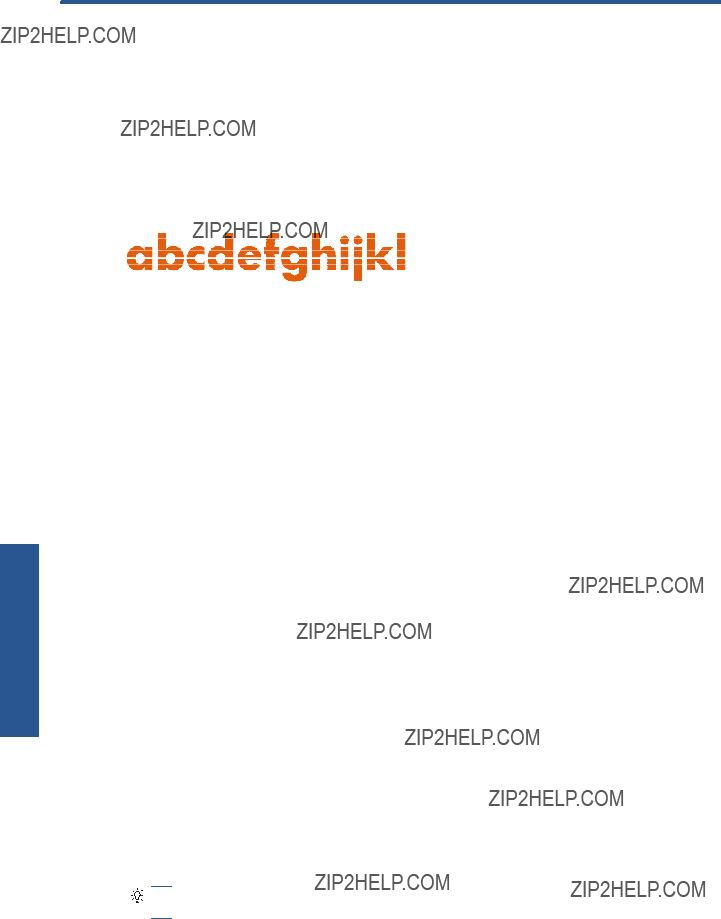
9
The print quality is not what you expect
issues Quality
1.Check the
2.Check the paper type setting. When printing on transparencies or other special paper types, select the corresponding paper type in the HP Print Settings dialog box.
3.For large sheets of paper (C- or
Starwheel marks are visible on the paper
Because of the coating used on HP Premium Photo Glossy Paper, starwheel marks may be visible on the coating, depending on the color and amount of ink used.
You are recommended to use this paper only when you need 2400 x 1200 dpi resolution. For premium presentation proofs, use HP Proofing Gloss Paper.
The image seems scrambled
1.Check that all required cables are securely connected to the printer. If you are using a parallel cable, check that it is also firmly connected to the computer and is IEEE 1284 compatible.
2.Check that the printer is selected as the current or default printer.
3.Your document may be corrupted. Try printing another file from the same software application.
4.If you are using the printer's parallel port, disable bidirectional communication or stop sharing the printer port with another device. There may be a conflict between the printer and other devices that share the port.
The page printed is wholly or partially blank
1.Check that all required cables are securely connected to the printer.
2.If you are using a parallel cable, check that it is IEEE 1284 compatible.
TIP: You are recommended to use a USB connection rather than a parallel connection if feasible.
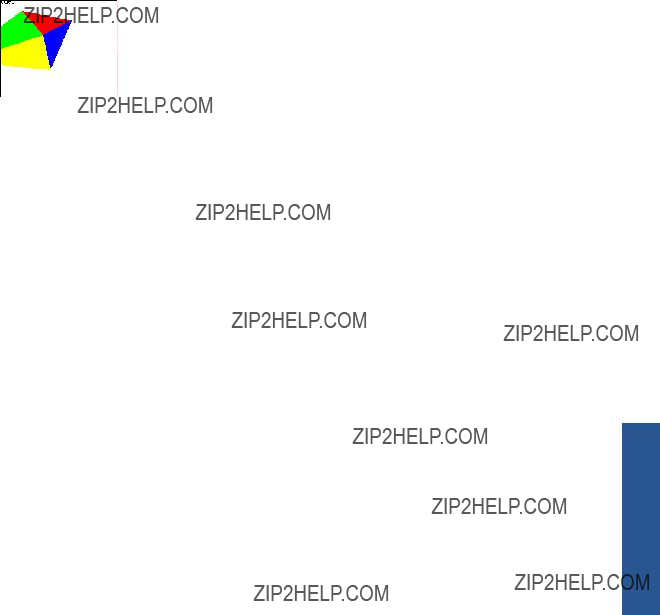
3.New printheads are shipped with a protective tape that covers the nozzles. Make sure that the protective tape covering each printhead is removed.
4.Check that the printer is selected as the current or default printer.
Text or graphics are truncated
1.The print preview from your HP Designjet software will tell you whether the configuration is correct: check the margins, the page size, the page orientation, and the scale factor.
2.If the text or graphics are cut off at the edges of the page, make sure the margin settings for the document do not exceed the printable area of your printer. See Printer minimum margins
3.The page orientation that you have selected may not be correct for the document you are printing. Check your print settings and try printing again.
Parts of the image are missing or misplaced
Check that the following settings are correctly set in the printer driver.
???The page size or paper size
???Scaling (the printed image should fit on the paper)
???Orientation
The printer seems to disregard the print settings
Some software applications allow you to set certain print settings, such as the print order. These print settings may differ from those specified in the printer driver.
Ensure that the print settings in the application match the settings in the driver.
Quality issues

10
All ink cartridge icons in the front panel are flashing
1.Remove all the ink cartridges. See Replace ink cartridges on page 26.
2.Return them one by one to their normal locations, making sure that each is firmly seated in the proper position.
3.If the corresponding icon stops flashing, that cartridge is OK.
4.If the icon continues to flash, replace the cartridge with a new one.
One ink cartridge icon in the front panel is flashing
1.Remove the ink cartridge in question. See Replace ink cartridges on page 26.
2.Return it to its normal location, making sure that it is firmly seated in the proper position.
3.If the icon stops flashing, the cartridge is OK.
4.If the icon continues to flash, replace the cartridge with a new one.
All printhead icons in the front panel are flashing
Replace all the printheads. See Replace printheads on page 27.
One printhead icon in the front panel is flashing
Replace the printhead in question. See Replace printheads on page 27.
issues Ink
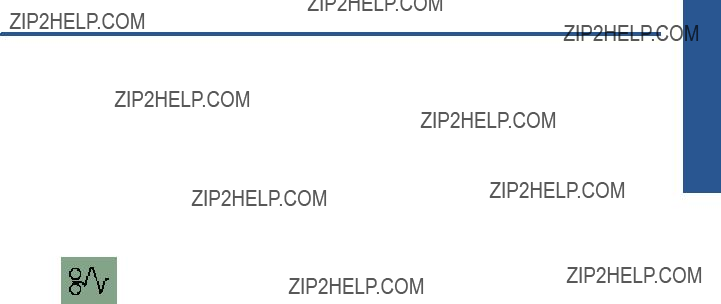
11 General printer issues
Paper is jammed in the printer
General issues
To clear a paper jam, first try pressing the OK key (upper right key on the printer's front panel).
If this does not solve the problem, follow the appropriate instructions below according to whether the printer was printing on a sheet or a roll when the jam occurred.
Sheet paper
1.Turn off the printer.
2.Remove all paper from the tray. Pull out any paper that is visibly stuck.
3.Lift the top cover and pull out any paper that may be stuck. Be careful when you lift the cover not to damage or disturb any of the tubes or other internal parts of the printer.
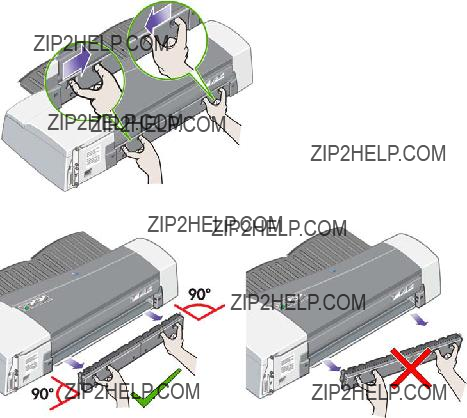
Removing the rear path gives access to the inside of the printer from the rear.
5.Pull out any paper that may be stuck inside or that is accessible from the rear.
6.Replace the rear path and make sure it fits securely.
7.Turn on the printer.
8.After clearing a paper jam, you are recommended to align the printheads to avoid
Roll paper
1.Turn off the printer.
2.Remove the front paper tray. This will allow you to see inside the printer through a slot in the front. Release and remove any trapped paper that is accessible.
3.Lift the top cover, being careful not to damage or disturb any of the tubes or other internal parts of the printer. If there is any paper trapped in the wheels inside the printer, release and remove the paper.
4.Remove the rear path by pressing the buttons on each of its sides and pulling it straight out. If you don't pull it straight out, you may damage the paper sensor. If there is any paper trapped in the rollers inside the printer, release and remove the paper.
5.Once the paper jam has been cleared, replace any parts of the printer (paper tray, top cover, rear path) that you have removed or opened, making sure they fit securely.
6.Turn on the printer.
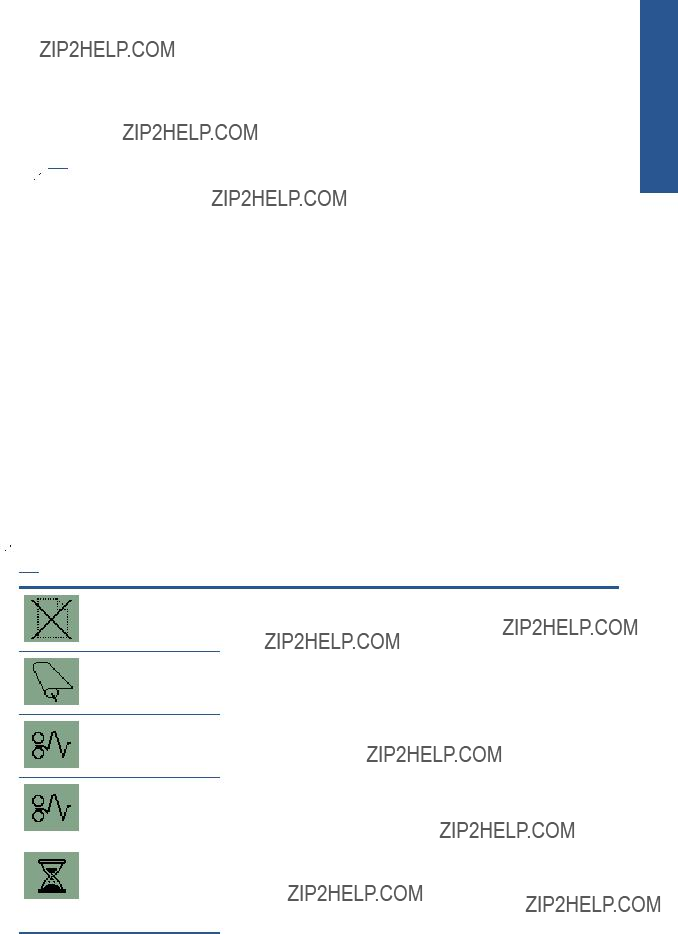
7.Before reloading the paper roll, you must trim the leading edge of the roll such that this edge is perfectly straight and at right angles to the sides of the roll. Otherwise, the printer will reject the roll when you attempt to reload it.
8.After clearing a paper jam, you need to clean the printheads only if there has been a degradation in performance. Similarly, you need to align the printheads only if there has been a degradation in print quality. To align printheads, start HP Designjet System Maintenance and select Align printheads; you do not need an Internet connection to do this.
 NOTE: Note that if the printheads are not aligned, you may obtain poor print quality.
NOTE: Note that if the printheads are not aligned, you may obtain poor print quality.
Avoid paper jams
Your printer is designed for
???Make sure nothing is blocking the paper paths.
???Load the paper correctly, without skew.
???Do not overload the tray. It holds up to 100 sheets of paper, depending on the paper width. When you load paper into the tray, use the width and length adjusters to avoid the paper skewing.
???Do not use paper that is curled or crumpled.
???Use the rear path for thick paper, up to 0.3 mm (0.012 in).
The printer's yellow light is flashing
Check the icons displayed on the front panel. The yellow light flashes for one of these reasons.
 NOTE: No icons are shown in the front panel if any cover is open or the rear paper path has been removed.
NOTE: No icons are shown in the front panel if any cover is open or the rear paper path has been removed.
The Paper Status icon flashes; the printer is out of paper.
See Paper handling on page 15.
The Roll icon flashes; the roll is empty or there is a paper jam. If the paper jam icon is also flashing, the roll must be unloaded manually.
See Paper handling on page 15.
The Paper Jam icon flashes; paper is jammed.
See Paper is jammed in the printer on page 39.
The Paper Jam icon is flashing, and the Busy icon is on; the carriage has stalled.
This may be caused by a paper jam. See Paper is jammed in the printer on page 39.
It may be caused by a printhead latch not being securely fastened. See Replace printheads on page 27.
It may be caused by a cable that has become loose inside the printer. If none of the other remedies works, call HP for assistance. See Contact HP Support
General issues

issues General
Both the Paper Status and the Paper Jam icons are flashing; the paper has stalled.
See Paper is jammed in the printer on page 39.
Both the Roll and the Paper Jam icons are flashing; the roll must be unloaded manually.
See Unload a roll of paper on page 21.
One or more of the Printhead Status icons are flashing; the printheads need replacing.
See Replace printheads on page 27.
The Use System Maintenance icon is on; there is a hardware error. Run the
System Maintenance tool for the printer.
See HP Designjet System Maintenance on page 34.
The Paper misaligned icon is flashing. The paper is misaligned and must be reloaded to print.
See Paper handling on page 15.
All the Ink Cartridge Status icons are flashing; there is an ink cartridge problem.
See All ink cartridge icons in the front panel are flashing on page 38.
One of the Ink Cartridge icons is flashing; the corresponding cartridge is empty.
The last block of the corresponding icon flashes if a cartridge is low on ink.
See Replace ink cartridges on page 26.
The input tray won???t fit
Try inserting and removing the tray two or three times. Normally this should resolve the problem. If it doesn't, see below.
Inside the slot where the tray goes there are two
Make sure that both latches are forward. If necessary, pull them towards you.

When you insert the tray, you should hear a click as the latches are pushed back; when you remove the tray, the latches click as they move forward.
The printer won???t take paper from the tray
1.Remove the tray from the printer.
2.Make sure that you have not put too many sheets in the tray. The tray will hold 70 sheets of plain paper, 50 sheets of coated paper, or 20 sheets of glossy paper
3.A newly opened packet of paper may need 'breaking', that is, the pages may need to be separated.
4.Make sure that the paper is correctly placed in the tray, tight against the far right corner of the tray.
5.Make sure that the two width and depth adjusters are up against the block of paper.
6.Place the tray back into the printer, making sure that it is fully inserted.
HP Gloss Paper pages stick together
When one page of HP Gloss is printed and stacked on top of another, they can stick together.
It takes longer than average for the ink to be absorbed into the paper and therefore more time for the ink to dry.
There is a default Dry time on setting in the HP Designjet software, which slows the release of a
 NOTE: Letting the samples dry overnight should improve the stackability.
NOTE: Letting the samples dry overnight should improve the stackability.
To prevent smearing, allow the print to complete its full print cycle (which includes a
 NOTE: In premium mode, the proof should not be stacked if possible, as dry time is longer. While dry time is five minutes for a proof in best mode, it takes ten minutes to dry for a proof in premium mode.
NOTE: In premium mode, the proof should not be stacked if possible, as dry time is longer. While dry time is five minutes for a proof in best mode, it takes ten minutes to dry for a proof in premium mode.
Always handle the paper carefully and by the edges. Avoid excessive folding and handling before and after printing to prevent damage to material coating.
General issues
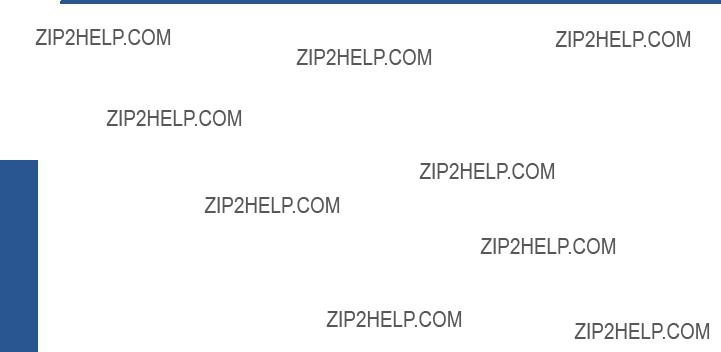
12 HP Customer Care
Care Customer
Introduction
HP Customer Care offers
To find out more about HP Customer Care, please visit us at:
or call us on the telephone (see Contact HP Support on page 45). To register your warranty:
Knowledge Center
Enjoy a world of dedicated services and resources to ensure you always get the best performance from your HP Designjet products and solutions.
Join the HP community at the Knowledge Center, your
???Multimedia tutorials
???
???Downloads ??? the latest printer firmware, drivers, software, paper presets, etc.
???Technical support ??? online troubleshooting, customer care contacts and more
???Workflows and detailed advice for completing various printing tasks from particular software applications
???Forums for direct contact with the experts, both HP and your colleagues
???Warranty tracking online, for your peace of mind
???Latest product
???Supplies Center for all you need to know about ink and paper
The Knowledge Center can be found at http://www.hp.com/go/111/knowledgecenter/.
By customizing your registration for the products you have purchased and your type of business, and by setting your communication preferences, you decide the information you need.
Contact HP Support
Telephone number
Your HP Support telephone number is available on the Web: please visit http://welcome.hp.com/ country/us/en/wwcontact_us.html.

Glossary
Bonjour
Bonjour is a networking protocol that uses IP but requires no configuration. You can use Bonjour to connect your printer to a network if you are running Mac OS.
Gateway
A gateway is a device that is used to provide connectivity between networks; for example, to connect two physically different networks, to manage the subnets inside of a network or to connect a network to the Internet. If there are no such devices on the network, the gateway field in the network configuration should be set to the same value as the IP address, then the Jetdirect card can act as its own gateway.
Hardware address
Every hardware component that is to be connected to a network (network card, Jetdirect print server, and so on) has a fixed hardware address, which is set during the manufacturing process; it cannot be changed and it distinguishes all network devices from one another. It is a number of 12 hexadecimal digits.
IP address
An IP address identifies a device in a TCP/IP network. It is composed of four bytes that can each take a value of between 0 and 255 (inclusive).
Example: 15.180.32.45
IP addresses can be changed, so it is possible to have two devices with the same IP address. If two devices in the same network have the same IP address, there will be conflicts, so special care must be taken when configuring the IP parameters for the network devices. Jetdirect cards come supplied with the IP address unconfigured, to avoid conflicts with other devices in the network. When the network card is first connected, it takes the IP address value 0.0.0.0. After a few minutes of being connected, the IP address changes to the default and
Subnet mask
The IP address of your printer contains sections that identify the network, the subnet, and the host within the subnet.
The subnet mask is used to separate and identify the bits of the IP address that are used for every section. Two devices that use different subnet masks won???t see each other even if they are physically connected to the same network. So the subnet mask has to be configured carefully and by following the instructions of your network administrator.
Example: 255.255.248.0
Syslog server
A syslog server is a device in the network that can receive and process status and error messages from the rest of network devices. If there is no syslog server on the network, it is recommended to set this value to 0.0.0.0 in order not to generate unnecessary traffic on the network.